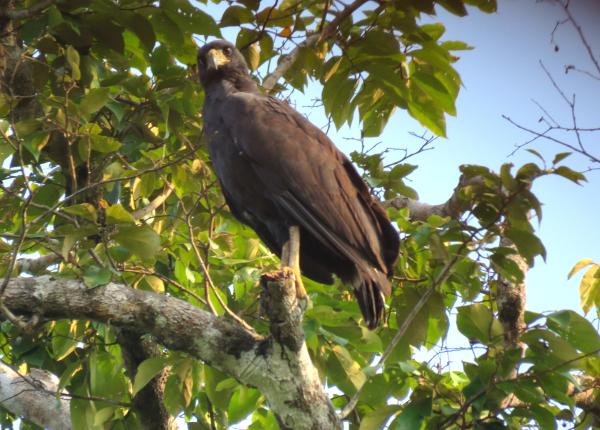Did You Know?
- There are two recognized subspecies of the Great Black Hawk
- Researchers have described it as a "sluggish, slow-moving hawk"
- This species is also known as Brazilian Urubitinga or Brazilian Eagle
- A juvenile Great Black Hawk received the top spot of the American Birding Associations "Top 10 List of Craziest Vagrants of 2018" when the same individual appeared first in Texas and, a few months later, in Maine! Sadly, this bird wasn't able to survive the cold winter temperatures and had to be euthanized due to frostbite.
How The Peregrine Fund is Helping
The Peregrine Fund doesn't work directly with Great Black Hawks but our efforts in scientific research, habitat conservation, education, and community development help conserve birds of prey around the world. We also supply literature to researchers from our avian research library, which helps scientists around the world gather and share important information on raptor conservation. We also support the Global Raptor Impact Network which gives raptor researchers tools to more efficiently conduct their own studies while contributing to a global program. GRIN also provides citizen scientists a way to participate in raptor science and conservation. Our work with the Neotropical Raptor Network also helps promote raptor conservation by enhancing communication and collaboration among raptor biologists working in the region.
Where They Live
The Great Black Hawk is a Neotropical species. It is found throughout much of South America, north into Central America through to northern Mexico, as well as the islands of Trinidad and Tobago. If you ever find yourself in Great Black Hawk territory, be sure to look for it soaring, perching or hunting near forest edges, and most often near bodies of water including lakes, large ponds, palm swamps, rivers, streams, or marshes. It can also be found in savannas, pastures, and fields.
What They Do
The Great Black Hawk, as its name implies, is a large, mostly all black bird of prey. It has yellow legs and a yellow cere, and dark eyes. It has relatively long legs and its tail is black and white. These juvenile hawks are more brown overall with brownish markings on the breast. The Great Black Hawk spends its time soaring very high, or perched. Researchers in Argentina have noted that, when not in breeding season, this species does engage in some altitudinal migrations.
Why They Need our Help
This bird of prey is categorized as a species of Least Concern. Though it is fairly common throughout much of its range, it might be at risk from habitat loss and shooting in some areas. However, all in all, the future looks pretty good for this large raptor.
What They Eat
This species consumes a large number of different prey species. It feeds on amphibians, fishes, lizards, snakes, birds, small mammals (including bats), crabs, large insects, carrion, and even fruits. It employs a number of different hunting techniques to capture different prey. When on the hunt, it might spend a long time perched, before dropping down onto unsuspecting prey. It also searches forest trees on the wing, searching for prey. It also hunts by walking on the ground. It will also search for something to eat among floating vegetation in shallow waterways. At times, it spends time around grass fires, where it catches animals fleeing from the flames and smoke.
Nests, Eggs, and Young
Great Black Hawks build a platform nest made of sticks constructed high up in an emergent tree or on power poles. The female will lay one egg which is white with red to purplish brown markings. The eggs must be incubated for between 35-37 days. After the nestling hatches, it will grow quickly. The male will work hard to bring enough food to the nest for the female and his offspring. The male will bring food close to or at the nest tree. The female will retrieve it and bring it to the nest and feed her offspring. When the nestling is around 40 days old, it will be ready to fly from the nest for the first time. After it fledges, it will remain with its parents for several months, learning how to hunt and survive on its own.
Great Black Hawk and the World Center for Birds of Prey
The World Center for Birds of Prey offers fun ways to learn about birds of prey. Interactive activities, tours, interesting videos and a children's room with activities from coloring sheets to quizzes to costumes are all available for our guests. We also have knowledgeable, on-site staff to answer any questions you may have about Great Black Hawks or any other bird of prey. Additionally, we have some hawk species as part of our Avian Ambassador team including a Harris' Hawk and a Swainson's Hawk.
References:
https://blog.aba.org/2019/01/the-top-10-craziest-vagrants-of-2018.html
Global Raptor Information Network. 2021. Species account: Great Black Hawk Buteogallus urubitinga. Downloaded from http://www.globalraptors.org on 6 Sep. 2021
van Dort, J. (2020). Great Black Hawk (Buteogallus urubitinga), version 1.0. In Birds of the World (T. S. Schulenberg, Editor). Cornell Lab of Ornithology, Ithaca, NY, USA. https://doi.org/10.2173/bow.grbhaw1.01










